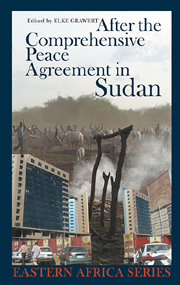Book contents
- Frontmatter
- Contents
- List of Tables & Figures
- Editor's Preface
- Notes on Contributors
- List of Acronyms
- Map of Sudan
- 1 Introduction
- I Implementation & Potential of the CPA
- II Challenges Facing Post-war Societies in Sudan
- III The CPA in its Sub-regional Context
- IV Beyond the CPA
- Index
- EASTERN AFRICAN STUDIES
1 - Introduction
Published online by Cambridge University Press: 05 April 2013
- Frontmatter
- Contents
- List of Tables & Figures
- Editor's Preface
- Notes on Contributors
- List of Acronyms
- Map of Sudan
- 1 Introduction
- I Implementation & Potential of the CPA
- II Challenges Facing Post-war Societies in Sudan
- III The CPA in its Sub-regional Context
- IV Beyond the CPA
- Index
- EASTERN AFRICAN STUDIES
Summary
After a long process of peace negotiations, which started only three years after the outbreak of the second civil war in Sudan in 1983, a Comprehensive Peace Agreement (CPA) was signed on January 9, 2005 between the Government of Sudan (GOS) and the Sudan People's Liberation Movement/Army (SPLM/A). The CPA raised initial hopes that it would be the foundation stone for lasting peace in Sudan. With its key protocols on wealth and power sharing (GOS/SPLM/A 2004, 2004a), it addresses two root causes of the civil wars in southern Sudan that had devastated the region from 1955 to 1972 and again, after eleven years of peace, from 1983 to 2004. These were economic marginalisation of the South and a near-exclusion of southerners from positions in government. The following introductory sections present the details of the CPA and outline the problems facing its implementation. Finally an overview of the sections and papers in this book is provided.
Background and key issues of the CPA
The CPA officially and de facto ended the civil war in southern Sudan after a long process that had suffered many setbacks. It had started in 1986 with negotiations between factions of the formally democratic coalition government under Sadig el-Mahdi and the SPLM/A leadership. The coup d’état of 1989 by Lt. Omar Hassan el-Bashir, backed by the Muslim Brotherhood led by Hassan el-Turabi, was a heavy blow to a nearagreement. During the 1990s, negotiations intensified again under the umbrella of the Inter-governmental Authority for Development (IGAD), which includes the governments of Djibouti, Eritrea, Ethiopia, Kenya, Somalia and Sudan.
- Type
- Chapter
- Information
- After the Comprehensive Peace Agreement in Sudan , pp. 1 - 26Publisher: Boydell & BrewerPrint publication year: 2010

